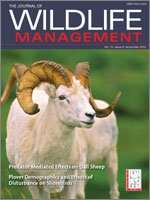Occupancy models that account for imperfect detection are often used to monitor anuran and songbird species occurrence. However, presence–absence data arising from auditory detections may be more prone to observation error (e.g., false-positive detections) than are sampling approaches utilizing physical captures or sightings of individuals. We conducted realistic, replicated field experiments using a remote broadcasting system to simulate simple anuran call surveys and to investigate potential factors affecting observation error in these studies. Distance, time, ambient noise, and observer abilities were the most important factors explaining false-negative detections. Distance and observer ability were the best overall predictors of false-positive errors, but ambient noise and competing species also affected error rates for some species. False-positive errors made up 5% of all positive detections, with individual observers exhibiting false-positive rates between 0.5% and 14%. Previous research suggests false-positive errors of these magnitudes would induce substantial positive biases in standard estimators of species occurrence, and we recommend practices to mitigate for false positives when developing occupancy monitoring protocols that rely on auditory detections. These recommendations include additional observer training, limiting the number of target species, and establishing distance and ambient noise thresholds during surveys.
How to translate text using browser tools
1 November 2010
Experimental Investigation of Observation Error in Anuran Call Surveys
Brett T. McClintock,
Larissa L. Bailey,
Kenneth H. Pollock,
Theodore R. Simons
ACCESS THE FULL ARTICLE
It is not available for individual sale.
This article is only available to subscribers.
It is not available for individual sale.
It is not available for individual sale.

Journal of Wildlife Management
Vol. 74 • No. 8
November 2010
Vol. 74 • No. 8
November 2010
auditory detection
aural detection
detection probability
False negative
false positive
imperfect detection
monitoring




